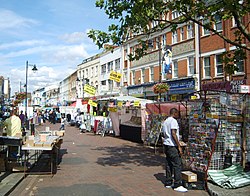
The Camden markets are a number of adjoining large retail markets, often collectively referred to as Camden Market or Camden Lock, located in the historic former Pickfords stables, in Camden Town, London. It is situated north of the Hampstead Road Lock of the Regent's Canal. Famed for their cosmopolitan image, products sold on the stalls include crafts, clothing, bric-a-brac, and fast food. It is the fourth-most popular visitor attraction in London, attracting approximately 250,000 people each week.

A hawker is a vendor of merchandise that can be easily transported; the term is roughly synonymous with costermonger or peddler. In most places where the term is used, a hawker sells inexpensive goods, handicrafts, or food items. Whether stationary or mobile, hawkers often advertise by loud street cries or chants, and conduct banter with customers, to attract attention and enhance sales.
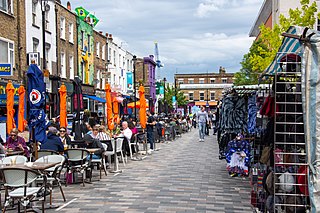
Inverness Street Market is an outdoor street market in Camden, North London. Licences to trade are issued by Camden London Borough Council.

Taiwanese night markets are street markets in Taiwan that operate in urban or suburban areas between sunset and sunrise. A few, such as Huaxi Street Tourist Night Market, use purpose-built marketplaces, but most occupy either sidewalks or even entire streets that carry vehicle and pedestrian traffic by day. Some night markets in smaller side streets and alleys feature retractable roofs. Most night markets operate daily and feature a mixture of individual stalls selling clothing, consumer goods, xiaochi, and specialty drinks. The atmosphere is usually crowded and noisy with hawkers shouting and fast-paced music playing over loudspeakers. Taiwanese night markets have evolved over the years from small, local gatherings to noisy streets lined with vendors, who must adhere to regulations placed on their activities by the Taiwanese government.
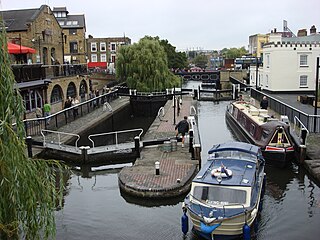
Camden Lock is a small part of Camden Town, London Borough of Camden, England, which was formerly a wharf with stables on the Regent's Canal. It is immediately to the north of Hampstead Road Locks, a twin manually operated lock. The twin locks together are "Hampstead Road Lock 1"; each bears a sign so marked. Hawley Lock and Kentish Town Lock are a short distance away to the east; to the west is a long level pound — it is 27 miles (43 km) to the next lock.

Kirkgate Market is a market complex on Vicar Lane in the city centre of Leeds, West Yorkshire, England. It is the largest covered market in Europe and a Grade I listed building. There are currently 800 stalls which attract over 100,000 visitors a week.

Exmouth Market is a semi-pedestrianised street in Clerkenwell in the London Borough of Islington, and the location of an outdoor street market of 32 stalls.

A marketplace or market place is a location where people regularly gather for the purchase and sale of provisions, livestock, and other goods. In different parts of the world, a marketplace may be described as a souk, bazaar, a fixed mercado (Spanish), or itinerant tianguis (Mexico), or palengke (Philippines). Some markets operate daily and are said to be permanent markets while others are held once a week or on less frequent specified days such as festival days and are said to be periodic markets. The form that a market adopts depends on its locality's population, culture, ambient and geographic conditions. The term market covers many types of trading, as market squares, market halls and food halls, and their different varieties. Thus marketplaces can be both outdoors and indoors, and in the modern world, online marketplaces.
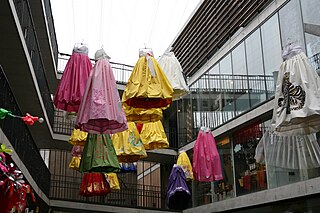
Seoul, South Korea has many shopping areas and markets throughout the city, including Myeong-dong, Cheongdam-dong, Hongdae area, Dongdaemun and Namdaemun markets.

Ridley Road Market but often referred to as "Dalston Market" is the central marketplace in Dalston in the London Borough of Hackney. It is opposite Dalston Kingsland railway station, just off the Kingsland High Street section of the A10, about three miles north of the City of London. It sells a wide range of commodities, including food. Goods, particularly fruit and vegetables, are sold from traditional barrows (trolleys) in the pedestrianised street from 8am to 6pm daily. There is a large range of traditional and exotic produce from around the world. Other stalls and many other shops lining the street sell a wide variety of foods and household goods. New style stalls have recently been introduced by the local council.

Norwich Market is an outdoor market consisting of around 200 stalls in central Norwich, England. Founded in the latter part of the 11th century to supply Norman merchants and settlers moving to the area following the Norman conquest of England, it replaced an earlier market a short distance away. It has been in operation on the present site for over 900 years.
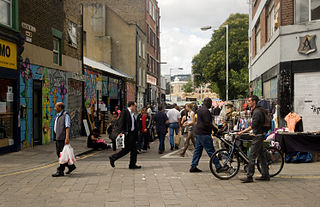
Brick Lane Market is the collective name for a number of London markets centred on Brick Lane, in Tower Hamlets in east London. The original market was located at the northern end of Brick Lane and in the heart of east London's Bangladeshi community but now commonly refers to the various markets that are housed along the famous London street. The various markets that stretch the length of Brick Lane operate both weekdays but most historically weekends: Saturday from 11 a.m. to 6 p.m. and Sunday from 10 a.m. to 6 p.m.

Whitechapel Road market, also known as Whitechapel Market is a long-established historic London outdoor street market managed by the London Borough of Tower Hamlets which is centered on the A11 thoroughfare of the same name in Whitechapel in the East End of London, next to Whitechapel station and is the focus point of the Whitechapel Market Conservation Area that was set up in 1997 and extended in 2008.

Maltby Street Market is a weekly street-food and provisions market in Bermondsey, southeast London, England. The market is located on a street of the same name near Tower Bridge in the old Horselydown parish of Bermondsey.

Chalton Street Market is a street market in Camden, North London.
